北师大版(2019)选择性必修 第三册Unit 9 Human Biology Lesson 1 To Clone or Not to Clone 课件(共20张PPT)
文档属性
| 名称 | 北师大版(2019)选择性必修 第三册Unit 9 Human Biology Lesson 1 To Clone or Not to Clone 课件(共20张PPT) | 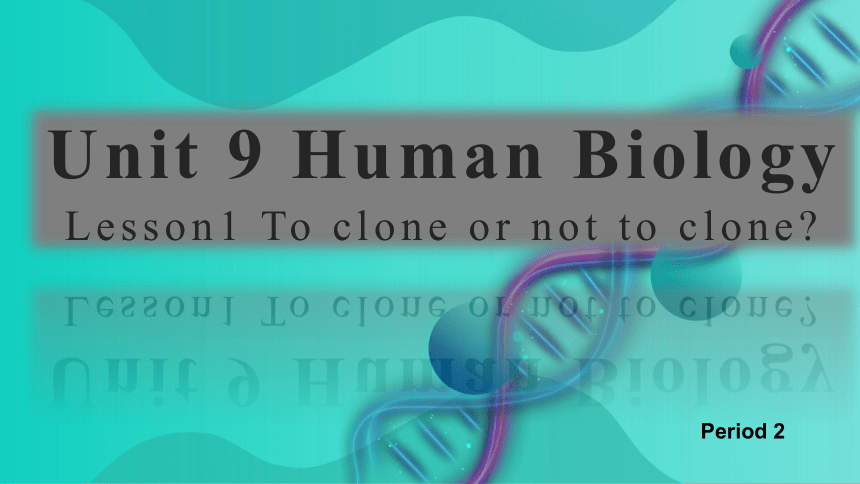 | |
| 格式 | pptx | ||
| 文件大小 | 44.5MB | ||
| 资源类型 | 教案 | ||
| 版本资源 | 北师大版(2019) | ||
| 科目 | 英语 | ||
| 更新时间 | 2024-03-25 20:55:38 | ||
图片预览


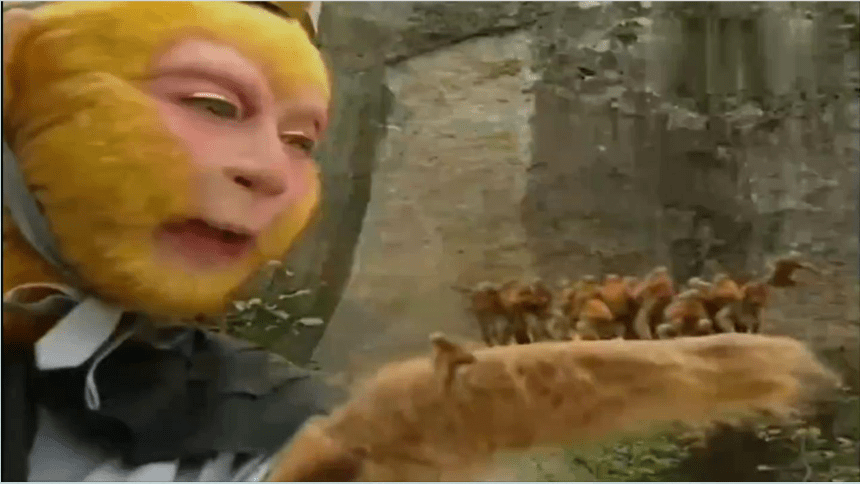

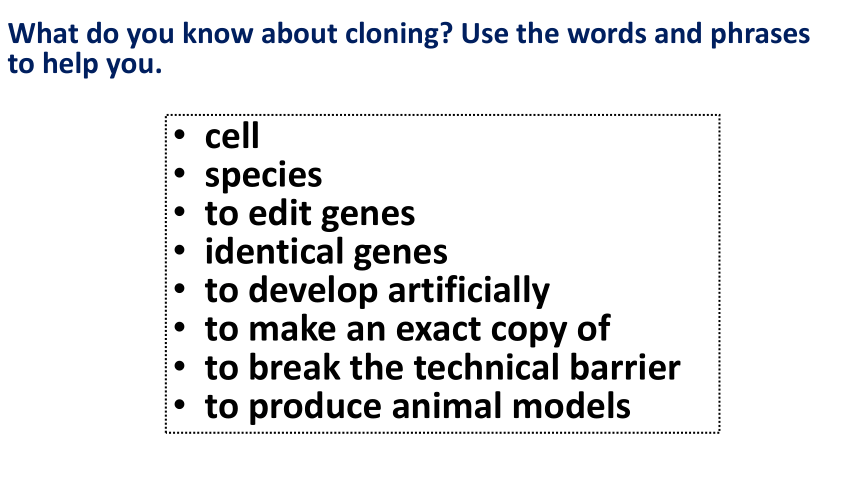
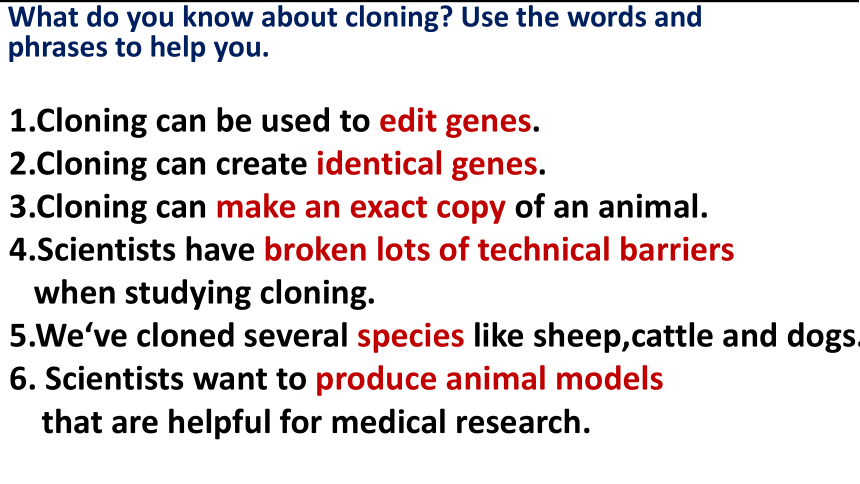

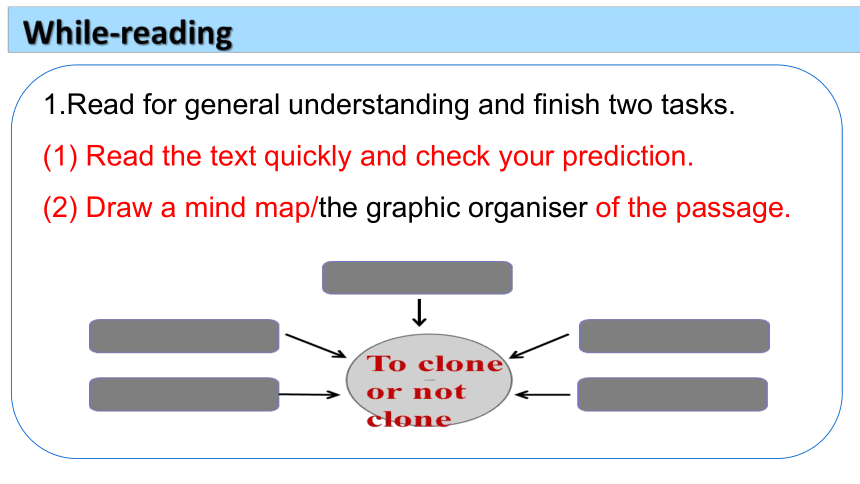
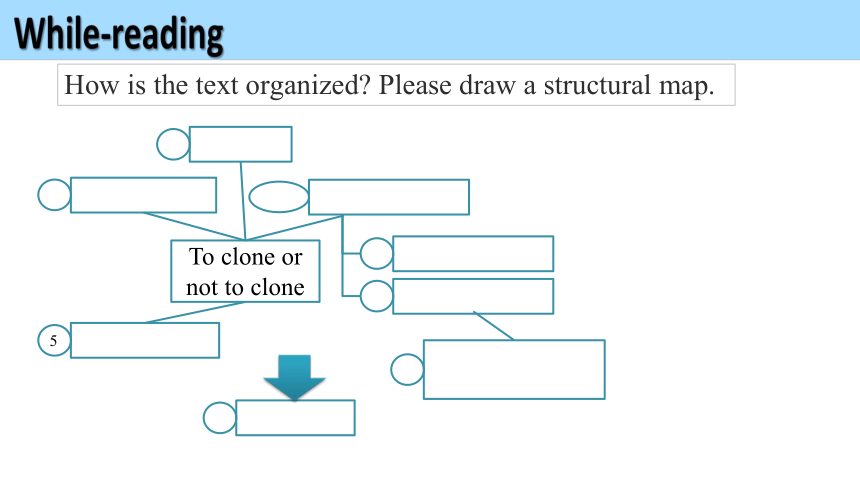
文档简介
(共20张PPT)
Unit 9 Human Biology
Lesson1 To clone or not to clone
Period 2
Journey to the West
What do you know about cloning Use the words and phrases to help you.
cell
species
to edit genes
identical genes
to develop artificially
to make an exact copy of
to break the technical barrier
to produce animal models
What do you know about cloning Use the words and phrases to help you.
1.Cloning can be used to edit genes.
2.Cloning can create identical genes.
3.Cloning can make an exact copy of an animal.
4.Scientists have broken lots of technical barriers
when studying cloning.
5.We‘ve cloned several species like sheep,cattle and dogs.
6. Scientists want to produce animal models
that are helpful for medical research.
Look at the title and pictures. Make predictions about the text.
While-reading
To clone or not to clone
What would you write if you were invited to write such a passage
opinions
what
development
Step3 While-reading
1.Read for general understanding and finish two tasks.
(1) Read the text quickly and check your prediction.
(2) Draw a mind map/the graphic organiser of the passage.
To clone or not to clone
5
How is the text organized Please draw a structural map.
cloning
Definition
Natural cloning
first
cloning
First-cloned primates
positive and negative opinions
writer’s
attitude
Cloning
1. Definition
2. Natural cloning
3. First cloning
4. First-cloned primates
5. Positive and negative opinions
6. Writer’s attitude
Draw a structual map to show how the paragraphs are organised.
To clone or not to clone
Para 1
Para 2-3
Para4- 5
Para 6
Definition
Natural cloning
P2: cloned mammals
Artificial cloning
P3: cloned primates
Positive opinions &Moral concerns
Conclusion
Draw a structual map to show how the paragraphs are organised.
To clone or not to clone
Para 1
Para 2-3
Definition
Natural cloning
P2: cloned mammals
Artificial cloning
P3: cloned primates
3.What was the first cloned mammal
What happened to her
4.How has the science of cloning developed since the first cloned mammal
5.What development in cloning was announced in 2018 What was special about it
6. For how long did Dr.Sun Qiang's team work Why did they work so hard
1.What is cloning
2 .What examples of natural cloning
are given
activity 2
P53 4
Para 1
Read and answer the questions
1. What is cloning
2. What examples of natural cloning are given
3. What was the first cloned mammal What happened to her
4. How has the science of cloning developed since the first cloned mammal
Para2
5. What development in cloning was announced in 2018
What was special about it
6. For how long did Dr. Sun Qiang's team work
Why did they work so hard
Around the clock
Draw a structual map to show how the paragraphs are organised.
To clone or not to clone
Para 1
Para 2-3
Para4- 5
Para 6
Definition
Natural cloning
P2: cloned mammals
Artificial cloning
P3: cloned primates
Positive opinions &Moral concerns
Conclusion
Read paragraphs 4-5. Check answers.
P54 5
Potential benefits Moral concerns
will lead to cures for various diseases has refreshed the technical possibility of cloning of other species
prevent aging
save research time
reduce the number of animals being tested on
producing more accurate results
better treatments
clones should be treated as objects or individuals
clones are inferior
some organizations may abuse the technology
Read paragraph 6 and pay attention to the quote.
What does Einstein’s quote mean
So far, it is still unknown what Will happen to Zhong Zhong and Hua Hua as they grow up. Researchers insist that the science of cloning should be further explored and advanced. As Einstein said, “Science is a powerful instrument. How it is used, whether it is a blessing or a curse to mankind, depends on mankind and not on the instrument. A knife is useful, but it can also kill.”
Para.6
Einstein’s quote means that science itself can’t be judged as good or bad, because it can only function when it is used by humans. He also indicates humans need to be careful with the information they learn through science and to remember to use science for good.
Thank you for listening!
Unit 9 Human Biology
Lesson1 To clone or not to clone
Period 2
Journey to the West
What do you know about cloning Use the words and phrases to help you.
cell
species
to edit genes
identical genes
to develop artificially
to make an exact copy of
to break the technical barrier
to produce animal models
What do you know about cloning Use the words and phrases to help you.
1.Cloning can be used to edit genes.
2.Cloning can create identical genes.
3.Cloning can make an exact copy of an animal.
4.Scientists have broken lots of technical barriers
when studying cloning.
5.We‘ve cloned several species like sheep,cattle and dogs.
6. Scientists want to produce animal models
that are helpful for medical research.
Look at the title and pictures. Make predictions about the text.
While-reading
To clone or not to clone
What would you write if you were invited to write such a passage
opinions
what
development
Step3 While-reading
1.Read for general understanding and finish two tasks.
(1) Read the text quickly and check your prediction.
(2) Draw a mind map/the graphic organiser of the passage.
To clone or not to clone
5
How is the text organized Please draw a structural map.
cloning
Definition
Natural cloning
first
cloning
First-cloned primates
positive and negative opinions
writer’s
attitude
Cloning
1. Definition
2. Natural cloning
3. First cloning
4. First-cloned primates
5. Positive and negative opinions
6. Writer’s attitude
Draw a structual map to show how the paragraphs are organised.
To clone or not to clone
Para 1
Para 2-3
Para4- 5
Para 6
Definition
Natural cloning
P2: cloned mammals
Artificial cloning
P3: cloned primates
Positive opinions &Moral concerns
Conclusion
Draw a structual map to show how the paragraphs are organised.
To clone or not to clone
Para 1
Para 2-3
Definition
Natural cloning
P2: cloned mammals
Artificial cloning
P3: cloned primates
3.What was the first cloned mammal
What happened to her
4.How has the science of cloning developed since the first cloned mammal
5.What development in cloning was announced in 2018 What was special about it
6. For how long did Dr.Sun Qiang's team work Why did they work so hard
1.What is cloning
2 .What examples of natural cloning
are given
activity 2
P53 4
Para 1
Read and answer the questions
1. What is cloning
2. What examples of natural cloning are given
3. What was the first cloned mammal What happened to her
4. How has the science of cloning developed since the first cloned mammal
Para2
5. What development in cloning was announced in 2018
What was special about it
6. For how long did Dr. Sun Qiang's team work
Why did they work so hard
Around the clock
Draw a structual map to show how the paragraphs are organised.
To clone or not to clone
Para 1
Para 2-3
Para4- 5
Para 6
Definition
Natural cloning
P2: cloned mammals
Artificial cloning
P3: cloned primates
Positive opinions &Moral concerns
Conclusion
Read paragraphs 4-5. Check answers.
P54 5
Potential benefits Moral concerns
will lead to cures for various diseases has refreshed the technical possibility of cloning of other species
prevent aging
save research time
reduce the number of animals being tested on
producing more accurate results
better treatments
clones should be treated as objects or individuals
clones are inferior
some organizations may abuse the technology
Read paragraph 6 and pay attention to the quote.
What does Einstein’s quote mean
So far, it is still unknown what Will happen to Zhong Zhong and Hua Hua as they grow up. Researchers insist that the science of cloning should be further explored and advanced. As Einstein said, “Science is a powerful instrument. How it is used, whether it is a blessing or a curse to mankind, depends on mankind and not on the instrument. A knife is useful, but it can also kill.”
Para.6
Einstein’s quote means that science itself can’t be judged as good or bad, because it can only function when it is used by humans. He also indicates humans need to be careful with the information they learn through science and to remember to use science for good.
Thank you for listening!
